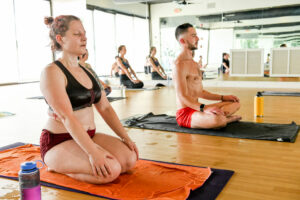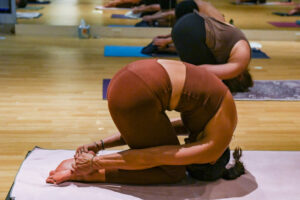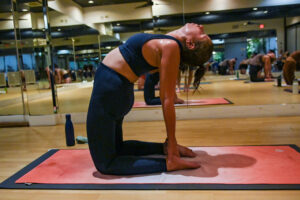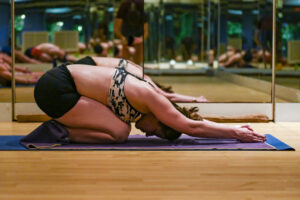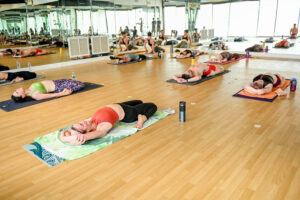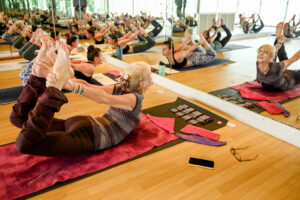Dandayamana-Janushirasana: Standing head to knee pose
“…lock the knee, lock the knee, lock the knee…”
When you hear that pose named, how does it make you feel? In my own yoga journey, I’ve had a love/hate relationship with Standing Head to Knee Pose.
Standing Head to Knee Pose from the Beginning
The first time I saw standing head to knee pose, I thought, nope. This body could never do that.
However, practicing in a safe and supportive environment at YogaSol in Norwalk, CT, taught me to first enjoy what my body can do. And then celebrate progress as I practice consistently.
In those first classes, I learned to enjoy that I could stand on one leg. That I could lift my knee to hold my foot in my clasped hands. That I could LOCK the knee of my standing leg to form a firm foundation. And then I enjoyed that I could stand there in that position. Full stop. That was it. I could stand.
Eventually, I found joy in progressing beyond stage one. And when I say eventually, it took my attending hot yoga class after class before I started to extend my lifted leg.
The other day I was reading how standing head to knee pose is a lifetime journey.
It made me wonder if the biggest mistake in practicing standing head to knee, especially for beginners, is trying to do too much too fast.
So, let’s dig in and talk about how to practice standing head to knee pose correctly.
Before you move on, here’s how you can choose your own adventure with this post.
- Skip to the Health Benefits of Standing Head to Knee Pose
- View Modifications of Standing Head to Knee Pose
- Want personal instruction on your Standing Head to Knee Pose? Join us for a posture clinic where Olivia Anselmo dives deep into Eagle Pose and Standing Head to Knee on Thursday, September 22.
How to do Standing Head to Knee Pose
Stage 1: Balancing
Stage one of the Standing Head to Knee pose is arguably the most important for your long-term health. Just head to the benefits of this pose below to see why.
Stage one is all about balance. You focus solely on your standing leg. Distribute your weight evenly on one foot. Then LOCK YOUR KNEE! That’s not really yelling at you about locking your knee. But it is to emphasize the importance of locking your knee on your standing leg.
Here’s how this can go wrong…
Before you lift your other foot from the floor, you lock your knee. Then you lift your foot. Once you start focusing on your lifted foot, you forget to keep your quad or the front of your thigh engaged.
That’s why you’ll hear your yoga teacher repeating, “lock the knee” throughout this pose. They’re reminding you to keep that thigh engaged, so you have a steady foundation to complete the pose.
Focus on your standing leg
Keep your focus on engaging the standing leg during the entirety of the pose. Until you master keeping that knee locked and balancing on one foot, you shouldn’t proceed to any other stage.
If you’re lifting your big toe on your standing leg and shifting your weight to the outside of your foot, wait until you are steady, with your weight evenly distributed on your one foot before you proceed.
Sometimes this stage takes weeks or months to master. The key is mastering one stage BEFORE you move onto the next stage. Mastery of each stage of a pose allows you to move deeper into the pose without injury.
Sometimes people forget about mastery because they are comparing their practice to the practice of others.
Here at the YogaSol hot yoga studio in Norwalk, we encourage mastery, safety, and the uniqueness of your personal journey. There’s no need to compare yourself to anyone other than yourself.
Mastery and a consistent practice will help you get and stay stronger for longer.
Until you master the stage, focus on the somatic experience of fully feeling your body in this stage of the pose.
Clasp the Foot
You’ve fully engaged your standing leg and are balancing on one leg. That’s when it’s time to lift your other foot, pulling the knee up. And keeping the standing leg engaged, make a basket with your hands and clasp your foot. Once you’re able to stand balanced and strong in this position for the full time of the pose, you’re ready to move to stage two.
Stage Two: Extending
In stage two of standing head to knee pose, you kick out from your foot against your clasped hands, extending your leg. The first time you kick out, your focus should remain on your standing leg. Maintaining your balance is more important that fully extending your leg.
Remember, beginning the kick is progress!
Once you can begin the leg extension while remaining stable, continue to full extension of the leg. And then, just as with your standing leg, lock the knee. When you fully extend and lock the knee, you should be engaging your thigh and butt muscles in both legs.
When all toes are up, your foot is fully flexed, and the top of your foot is facing the front of your body, it’s time to bend your elbows.
You’ll know you’ve mastered the extension stage when you’re locked and stable, AND you can bend your elbows until they’re just below your calves.
Again, this stage might take weeks or months or years to master. And some days will feel better than others. Do NOT give up if you feel like you’re moving backward in this pose.
The consistent practice will pay off. Plus, if you’re feeling stuck, it’s the perfect time to chat with your teacher about your progress or attend one of our posture clinics.
We’re here to help you keep moving forward!
Read about the 5 Reasons You Need a Yoga Posture Clinic
Stage Three: Tuck
You’ve built a firm foundation in stages one and two. And you’ve set yourself up to tuck that head to your knee. We’re finally moving into the full “head to knee” position.
As you’ve practiced in stages one and two, take your time moving that head toward your leg. We have many members who have practiced with us for years, and they have not yet reached stage three. They are still working on maintaining their balance in stages one and two.
Stage three is an advanced position for any yogi. So, go at your own pace getting that forehead to touch your knee.
Stage Four: Hold it!
Stage four can feel like the most difficult stage of all. But not if you’ve taken your time to fully master stages one through three. If you’ve built a firm foundation of balance and stability before moving into a new stage, you’ll be able to hold it like a pro.
The key to holding the pose with your forehead touching your knee, is to keep your knees locked and fully engage your thighs, your butt, and your abs.
Standing Head to Knee Pose Modifications
One question we’re often asked is whether or not there are any modifications for the pose while you’re mastering each stage.
- Focus point. It’s not so much a modification, but if you’re having trouble with this pose at any time, find a focus point on the floor just in front of you. It helps you maintain your balance. And this pose is all about focus and balance.
- Pace yourself. Remember that the BEST modification is taking this pose at your own pace.
- Mastery. Master each stage of this pose before moving into the next stage.
- Ask for help. If you’re feeling stuck, ask your teacher for help.
- Use a strap. If you practice this pose at home, you can use a strap to full extend your top leg in stage 2.
- Attend a posture clinic. To burst through plateaus and take your practice to the next level, attending a posture clinic can help!
Health Benefits of Standing Head to Knee
I’m betting you can guess what the biggest health benefits are to the Standing Head to Knee Pose. But just in case you’re wondering, here are the top three below.
Balance
Dr. Peter Attia, MD focused on the science of longevity says, “as we age, the consequences of losing your balance tip from inconvenient to devastating to potentially life-ending.” As a matter of fact, this report from the CDC says falls are the leading cause of death after the age of 65.
A key way to decrease our risk of falling is to increase our ability to balance at all ages.
On top of that, Dr. Peter Attia says balance is the foundation everyone needs in order to exercise (and move around in the world), no matter your age.
Because this pose is all about balance, the standing head to knee pose can help you achieve more balance in your every day life.
Lengthens Hamstrings
We put a TON of focus into locking the knee in standing head to knee pose. And what we’re really talking about is flexing the quadricep (aka – the thigh) and the butt. Because we’re contracting the thigh and the butt, that means we’re lengthening the hamstrings.
Why is that important?
Most of us sit for most of the day. In a seated position, our hamstrings contract. And spending the majority of our time with our hamstrings contracted can lead to back pain, sciatica, and even knee pain.
Standing head to knee pose lengthens the hamstrings and begins to undo some of the over-tightening we’re naturally prone to have from our desk jobs.
Strengthens Quads
Done right, this pose leads to thigh bulges in all the right places. The secret to more quad definition? Focus.
The fact that we’re instructing you to focus on contracting that quad muscle will lead to toning that muscle more than if you weren’t concentrating on the muscle.
Over the past few years, there are several research teams that have focused on muscle attention, and its results in hypertrophy. That’s just a fancy way of saying if you focus on contracting a muscle, you’ll actually develop it more than without focusing on it.
Here are three studies that show a correlation between these muscle gains and focus on the muscle you’re working.
European Journal of Sports Science Attentional Focus During Resistance Training
Muscle Activation Doubles Glutes
Those are just a few of the benefits you can gain from practicing the Standing Head to Knee Pose. Our biggest goal for you is progressing in your practice and doing it safely. Mastery is key.
p.s. If you’re near Norwalk, CT, and you want to practice hot yoga or pilates in a safe and supportive environment, come visit YogaSol. We help you go at your own pace while continually moving forward.
 -ing our NEW! Community Classes!
-ing our NEW! Community Classes!
